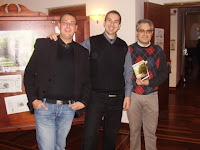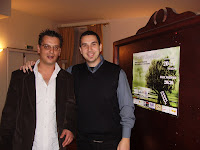
Corfu by night
Last evening, Corfu town was illuminated.
This picture was taken at Saroko square...
 It was rather too dark for my camera to catch the illuminated street. But it was a wonderful spectacle...
It was rather too dark for my camera to catch the illuminated street. But it was a wonderful spectacle...








e-mail: db_corfu@yahoo.gr

Εικαστική συνάντηση στο Βιρό
Συμμετέχουν
ο Γιάννης Μεταλληνός, ο Άγης Ξωμεριτάκης, ο Μάκης Ζερβός, η Ηλιάνα Μεταλληνού και η Ίνα Γερογιάννη.
Τα εγκαίνια της έκθεσης θα πραγματοποιηθούν το Σάββατο 24 Οκτώβρη, ώρα 19.00. Η έκθεση θα διαρκέσει έως τις 28 Οκτώβρη και θα είναι ανοικτή για το κοινό καθημερινά κατά τις ώρες 10.00 - 13.00 και 18.00 – 21.00.
Πληροφορίες: Ντίνος Μπαλανίκας, τηλ.6940046354, e-mail: db_corfu@yahoo.gr

 Now, I'll give you just the beginning of the interview, to get a taste of him. Here it goes:
Now, I'll give you just the beginning of the interview, to get a taste of him. Here it goes:
"Tell us about yourself first.
I was born in 1971 and grew up in Corfu. I have studied in Patras Polytechnic and I currently work at the Municipality of Thinalion as an Engineer. I live with my family in Corfu, which is the place I love and the place that is a permanent source of inspiration for my writing."
More about Nikos next time...
Thanks for visiting!
Liana



 Hello visitors!
Hello visitors!

 Alikes Potamou:
Alikes Potamou: on the beach offers a variety of fresh fish like grilled sardines that are delicious! Meat eaters can have chicken chops (the specialty of the taverna) or beef steaks and/or the dish of the day which usually includes a freshly cooked casserole with seasonal ingredients. The taverna is open all day long and in the evenings too, all year round.
on the beach offers a variety of fresh fish like grilled sardines that are delicious! Meat eaters can have chicken chops (the specialty of the taverna) or beef steaks and/or the dish of the day which usually includes a freshly cooked casserole with seasonal ingredients. The taverna is open all day long and in the evenings too, all year round.
 n centre, let alone enjoy so many facilities!
n centre, let alone enjoy so many facilities!
 s of dried soap and the equipment.
s of dried soap and the equipment.




 ion!
ion!References (Anafores)
Anafores is the title of the art exhibition taking place at the Public Library of the old castle. The artist is the Corfiot painter Demetra Kleronomou.
The paintings will be displayed at the Library till the 7th July.
Public can visit the exhibition on
Monday and Wednesday 12.30 to 19.00
Tuesday, Thursday and Friday 8.30 to 2.30
About the artist
Demetra Kleronomou was born in Karousades village in
Demetra has taken part in many group exhibitions in

Labatines (small fires)
Tonight Corfiots can attend the custom of Labatines (small fires) in two areas of the town: Benitses and Mandouki.
This custom takes place on the eve of Saint John Labataris. At Benitses village, the women’s association Athena organizes an event at 9:00, during which two fires will get lit in the square of the village. There is also going to be live music, dancing and treats!
At Mandouki area the cultural association of Mandouki people organizes a music event at the bus terminal to celebrate
According to the women’s association Athena, this special custom calls all the residents of the island to gather at a cross road during sunset to light labatines. In old days they used to make three stacks of hay and each household brought along their May flower ring to burn. The fires had to be three and always located on a three-way crossroad. When the fires burnt, the young people used to jump over the fire one by one, and they had to jump three times each over the fire. It is a great fun to watch and participate in this event!
 One of the most picturesque areas in Corfu town is Garitsa area. It is a green spot starting from Alexandras Avenue to Anemomylos place at the end of Garitsa bay.
One of the most picturesque areas in Corfu town is Garitsa area. It is a green spot starting from Alexandras Avenue to Anemomylos place at the end of Garitsa bay. residents.
residents.

Meet the animals, insects and plants living on the island.
SNAILS
‘Hi,
My name is Snail, but my Greek name is Saligari, or Bobolas in plain Corfiot language!
In my family we are in a variety of colors; the most common is brown with black stripes. White snails are quite common in fields with eatable plants such as lettuces, cabbages and broccoli (the green kind of cauliflower). I love the rain and I usually come out for a stroll after a nice heavy storm or a drizzle... I have to search for food, you see. That’s the time farmers really dislike me. Why? Read on to find out!
What do I eat?
Leaves; almost any kind of fresh green leaves will do. I am not too selective but I prefer those kinds human beings eat as they are the tastier. My worst time is when I go out to look for food because I am an easy prey. Birds catch me, you know, as I am part of the food chain. People eat me, too, but not very often since some of them think I am too slippery and creepy for their taste (I have to become more disgusting if I want to survive, but there are still those who find me cute; can you believe it? CUTE! How can a snail look cute?)
Well, I am an artifact too. My shell is a piece of art; people all over the world try to draw and paint my shell, so I am quite famous for my decorative designs. You can see lots of different shells at the
If you are online, you can learn more about my family here
http://www.geocities.com/sseagraves/allaboutsnails.htm
Now, would you like to read a story about me and my family?
Get the book titled The White Snail from a Corfiot bookshop or kiosk. Or visit my online address to order a signed copy at
http://toasprosaligari.blogspot.com’

The small
The Venetian culture
The Venetians cared for the olive oil production, so during their occupation
The Old Fortress
The Old Fortress is an excellent example of the fortification of the island that dates back to the Venetian times. This fortress has got a 60- meter bridge that links the castle to the square. Contra Fossa canal flows underneath and is currently used as a harbour for boats. At the entrance of the fortress there is the statue of Schulenburg who was a defender against the Turks. The fortress was first fortified by the Byzantines but the Venetians built complex tunnels and galleries to make it stronger. Inside the castle the visitor can see a prison building, the English Officers’ Quarters, the Barracks, the English Hospital and the chapel of Ayios Georgios, which is in Dorian style and was built by the English in 1840. From the top of the old fortress the traveler can see a panoramic view of
The New Fortress
The Venetians also built the New Fortress which is on the North West side of
The Esplanade
Another Venetian aspect that is still prevalent in Corfu town is the Esplanade (Spianada for the Corfiots) that is the heart of
More cultural influence
It is obvious that the Venetians influenced a lot the local architecture as well as all the other aspects of local life. Education was promoted and many institutions were set up, such as the music schools which are still running all over the island.




I have walked past that garden so many times, for so many years and have never noticed that plant! Funny, isn’t it?
I was born in that old house and played in that small garden, but I have always thought that plant was a palm tree. It was smaller at that time anyway, and I was a kid-kids hardly notice these things. I was more concerned about my cats and chicken and less about the banana tree. But yesterday, as I was walking past that spot once 
The first glimpse of that huge lamp- like flower deceived me; I thought-what is that, looks like a plastic lamp. You see it was hanging gracefully over the gate just in the middle of it. Exactly as a lamp should hang! Then I noticed a thick cord upwards that looked like a twisted wire. Looking up I saw the bananas; small green bananas facing the sky. You can see the pictures above. I had never seen a banana tree in b
I searched the net and found these links. Just in case you would like to plant a banana tree in your garden!
http://www.banana-tree.com/Banana_Tip.cfm
http://en.wikipedia.org/wiki/Banana



Who was Menecrates?
He was a famous Greek sculptor who lived in
The tomb should be restored and properly conserved but as it always happens here, it is abandoned along with the site next to it. Since the whole place has historical value-well, almost all the sites on the island have-the town council should do something about that. But I think they have run out of funds once more!
Menecrates' tomb which dates back to the 7th century BC is depicted here:
http://www.mlahanas.de/Greece/Cities/Corfu1892_03.html
The lion of Menecrates was found in
http://www.travel-to-corfu.com/photo.php?photo_id=64
Learn more about
http://www.kapatel.gr/tourism/corfu/index6.htm
